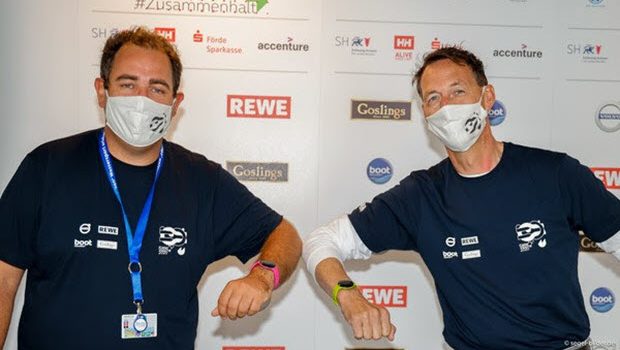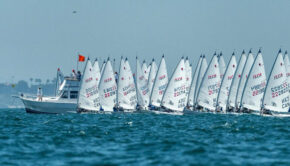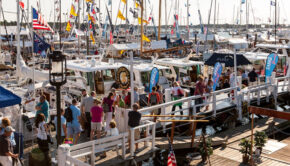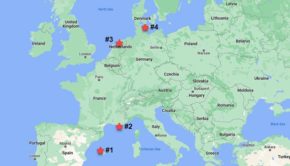Extraordinary effort for Kiel Week 2020
Published on September 8th, 2020
Located in northern Germany, Kiel Week is not just a massive sailing event but also one of the nation’s largest festivals, attracting millions of people every year for music, beer, and amusement.
But 2020 is different, with the 139th edition on September 5-13 focusing solely on its sailing roots. Hosting a wide range of one design and handicap classes, the second half of the schedule is for the Olympic events from September 10 to 13.
As the Olympic competition calendar has crumbled due to COVID-19, six of the ten events for Tokyo 2020 – 49er, 49er FX, Finn, Laser, Laser Radial, and Nacra 17 – will get on the water for competitors to commence training.
Postponed from its traditional June dates due to the pandemic, how does Kiel Week now plan to host German and international travelers yet prevent the spread of the disease among competitors, event administrators, and the local community?
Organizers of sailing events worldwide, but also politicians, ticketing companies, fair organizers as well as medical technology service providers are closely observing how COVID-19 is being handled.
With the decision in mid-March to postpone Kiel Week, but to take the risk of hosting it, work began on the existing hygiene concept – and it was intensive. “There was not a single day on which we did not work on it, at least subliminally,” said Sven Christensen, managing director of the marketing agency of Kiel Week.
“Ultimately, every question revolved around this topic, whether it was the layout of the areas, dealing with sponsors and partners, commissioning service providers or, more specifically, setting up the hygiene concept.
“And there had to be intensive communication – both internally and externally. Press, politics, helpers, volunteers and race organizers: All of them had their own, in the past clearly defined image of Kiel Week, which now had to be redrawn.”
The result is a strikingly different picture at the Kiel-Schilksee Olympic Center: hardly any tent and pagoda roofs, many open spaces where the dinghies have plenty of room, but instead plenty of fences, information boards and posters.
“We have defined sectors to which a maximum of 250 heads are assigned. Walkways were created,” explains Christensen. “But with the start of the week it became clear that the system had to be handled dynamically. So we restructured a bit.”
The Olympic Center is now divided into eight different areas. The sailing classes will be separated, but also the organizers should meet as little as possible. Security, check-in and race management will form separate cohorts. Chains of contacts will be prevented by the Kiel organizers.
Therefore the coaches have no access to the areas of the sailing classes. Since they often look after different athletes, the coaches should not be able to spread possible infections further. “If there is a case of infection, the measures should make it possible for us to remove one component without the entire structure collapsing,” says Christensen.
If the division into cohorts and the distribution of mouth-nose-masks (500 were produced in the Kiel Week design) as well as the use of a visitor warning light in the check-in boat tent is intended to prevent the occurrence of chains of infection from the outset.

Corona-Warnapp wristbands were already issued in the first part of the Kieler Woche. It is compatible with the German Smartphone-Warnapp. Photo: Sascha Klahn
The use of the Corona Warning Bracelet with the corresponding app serves to detect possible encounters and intervene in the chains if necessary. 850 wristbands are issued throughout the week. The bracelet is compatible with the Corona-Warnapp on the smartphone, but works even more accurately because the wristband is usually not put out of hand.
The heart of the actual testing for possible infections is located at the entrance to the regatta house. At the entrances to the organization area everyone has to pass a temperature test. If this is inconspicuous, access is granted. If the measuring device detects an infection, the next steps of the screening process begin.
First of all, a questionnaire clarifies the state of health, risk contacts, etc. Then the patient is taken to the test container with a new fever measurement. A special, voluntary rapid test is intended to provide further clarification by means of a new type of demonstration procedure of infrared spectral analysis. If there are no abnormalities, the path to sports is free again.
Otherwise, samples are taken for a PCR test and sent to the laboratory. Overnight there is then a result, which is received by the hygiene officer of the Kiel Yacht Club, Dr. Martin Lutz. So far, the handful of PCR tests have been negative. Also all of the approximately 300 spectral analyses did not yield a positive result.
The entire system has been set up by an internal working group at Point of Sailing with support from the medical and laboratory sectors. Now it is being intensively monitored by external parties. “Of course we also want people to see what we are doing,” says Sven Christensen. “Almost every day someone is there to take a look at the system on site. It is an incredible response.”
The Kiel Week organizers are basically satisfied with the acceptance among the participants, even if in individual cases there were corona skeptics among sailors and supervisors. At the beginning there were also discussions with some guests in the harbour who did not want to be led off their usual walking paths. And, of course, constant control and admonition is necessary to ensure that the masks are worn throughout the entire area.
“The general regulation are fixed and we enforce them,” notes Christensen. “In the end, however, it is up to each and every one of us to assume our responsibility to society as a whole.”
In Schilksee, a town within the city of Kiel, the scientists are using a new method to detect a disease with COVID-19 within a few seconds. “We want to offer a test for the general population that provides a result quickly and is not as complicated as a PCR test,” says Professor Maneesh Singh from England.
Together with his colleague, Singh takes swabs every day, from the mouth – not from the throat, and evaluates them using a spectral analysis. They clamp the saliva sample into a device and X-ray it. A high-purity diamond splits the light into a spectrum in which each chemical element leaves behind certain traces. The resulting curve is then examined by an algorithm on the computer.
“We have included samples from several thousand test persons in the algorithm, including a great number of people with an infection,” says Singh. The rate at which a positive sample can be detected in this way is 93 percent, Singh says.
In his imagination, the rapid test is intended to create a kind of funnel: Many people are tested in a very short time and a PCR test is carried out if anything abnormal occurs.
This should also reduce the burden on the laboratories. Prof. Dr. Dr. Patrick Warnke, a physician from Flensburg, is also involved in the development of the quick test. He actually wanted to use the spectrum analysis to detect other diseases.
The method has not yet been approved, so the procedure in Schilksee is a demonstration on a voluntary basis, but in several countries, including Germany, it will soon be released.
“So far we have had four participants who have attracted attention due to an increased temperature,” notes Singh. “Our test was negative, but to be on the safe side we ordered a PCR test. The result was reported the next morning: also negative.”
Singh and his colleague anticipate taking 500 to 1,000 samples with hopes they all prove to be negative.
Source: Scuttlebutt, Kiel Week










 We’ll keep your information safe.
We’ll keep your information safe.